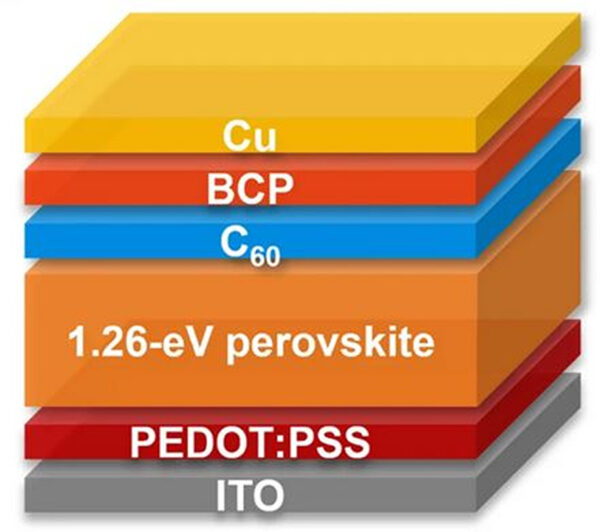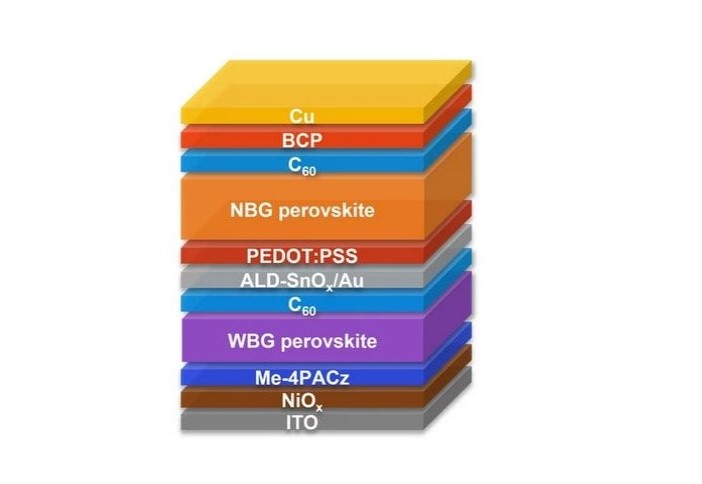A group of researchers led by the Wuhan University in China developed a two-terminal (2T) monolithic all-perovskite tandem solar cell that uses a tin-lead (Sn-Pb) perovskite material for the top cell.
The scientists explained that mixed Sn-Pb perovskites have a narrow bandgap (NBG) of approximately 1.26 eV, which makes them ideal for efficient light harvesting and current-matching with wide bandgap (WBG) subcells in all-perovskite tandem cells.
“However, NBG Sn-Pb perovskite solar cells show inferior efficiency and stability in comparison with their Pb-based counterparts because of the fast crystallization, which would lead to nonuniform nucleation,” they also specified. “The rapid crystallization of Sn perovskites causes poor quality of Sn-Pb perovskite films, hindering the fabrication of efficient all-perovskite tandem cells and impeding their commercialization.”
The research group sought to address this issue by gauging the mismatch in crystallization rates between Sn and Pb perovskites and modulating the grain growth and crystallization processes. It used, in particular, the N-(carboxypheny)guanidine hydrochloride (CPGCl) molecule, which is also known as 4-guanidinobenzoic acid hydrochloride, to reduce defects and tin oxidation in the perovskite absorber of the bottom cell.
“CPGCl molecules were utilized as dopants at a mole ratio of 1% in Sn-Pb perovskite precursor solutions,” the academics stressed. “These molecules had a greater impact on the delay of crystallization and grain growth in Sn perovskites, resulting in a delayed and balanced crystallization process in Sn-Pb mixed perovskites.”
The academics initially built the bottom cell with an indium tin oxide (ITO) substrate, a hole transport layer (HTL) based on PEDOT:PSS, the Sn-Pb perovskite absorber, an electron transport layer (ETL) based on a buckminsterfullerene (C60), a bathocuproine (BCP) buffer layer, and a copper (Cu) metal contact.

Image: Wuhan University, scientific reports, Creative Commons License CC BY 4.0
Tested under a reverse voltage scan, this cell achieved a power conversion efficiency of 23.15%, an open-circuit voltage of 0.88 V, a short-circuit current density of 32.77 mA cm–2, and a fill factor of 80.11%. The device was also able to retain 97.45% of its original efficiency after 3,500 h. “The improved device performance can be primarily attributed to the reduction in carrier recombination,” the scientists said. “Further enhancements in device stability could involve the use of solid encapsulation and stable charge transport layers.”
Popular content
The research team used then this cell to build the perovskite-perovskite tandem device. The latter was built with an ITO substrate, a hole transport layer (HTL) made of nickel(II) oxide (NiOx) and phosphonic acid called methyl-substituted carbazole (Me-4PACz), a wide bandgap (WBG) perovskite absorber, an ETL based on C60, a tin oxide (SnOx) buffer layer, an HTL based on PEDOT:PSS, the Sn-Pb perovskite absorber, an ETL based on C60, a BCP buffer layer, and Cu metal contact.
Tested under standard illumination conditions, the tandem call reached a maximum efficiency of 28.20 and a certified efficiency of 27.35%. It also achieved an open-circuit voltage of 2.13 V, a short-circuit current density of 16.27 mA cm–2, and a fill factor of 78.94%. This device was also able to retain 95.7% of the initial efficiency after being stored in a glovebox for 2,200 h.
The new solar cell concept was presented in the paper “Mixed tin-lead perovskites with balanced crystallization and oxidation barrier for all-perovskite tandem solar cells,” published in nature communications.
“Despite achieving high efficiencies in individual subcells, the efficiency of all-perovskite tandem cells lags significantly behind their theoretical limits,” the researchers concluded. “To fully exploit the potential of high-efficiency subcells, research is required to develop stable interconnection layers that reduce both electrical and optical losses in tandem cells.”
This content is protected by copyright and may not be reused. If you want to cooperate with us and would like to reuse some of our content, please contact: editors@pv-magazine.com.



By submitting this form you agree to pv magazine using your data for the purposes of publishing your comment.
Your personal data will only be disclosed or otherwise transmitted to third parties for the purposes of spam filtering or if this is necessary for technical maintenance of the website. Any other transfer to third parties will not take place unless this is justified on the basis of applicable data protection regulations or if pv magazine is legally obliged to do so.
You may revoke this consent at any time with effect for the future, in which case your personal data will be deleted immediately. Otherwise, your data will be deleted if pv magazine has processed your request or the purpose of data storage is fulfilled.
Further information on data privacy can be found in our Data Protection Policy.